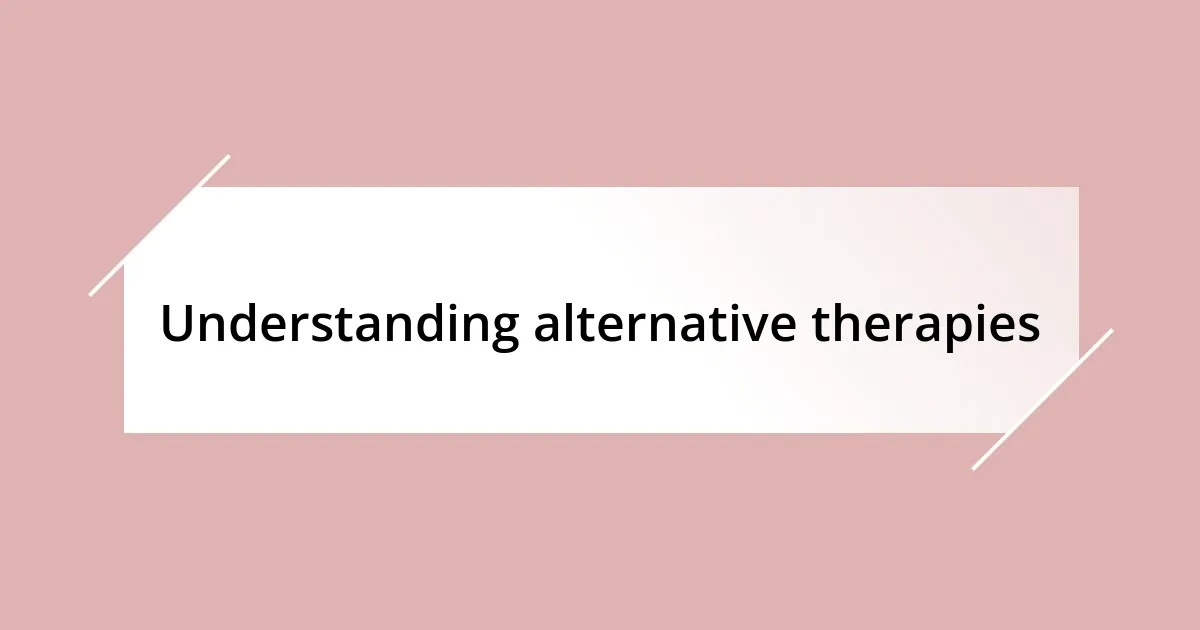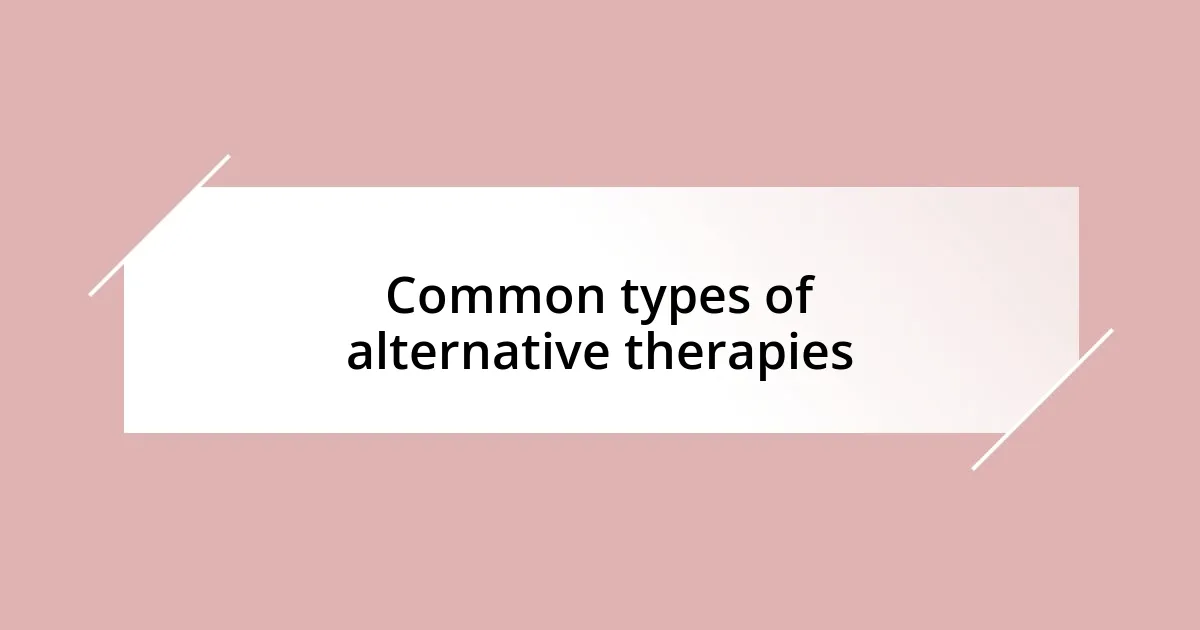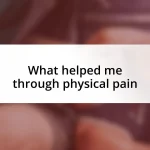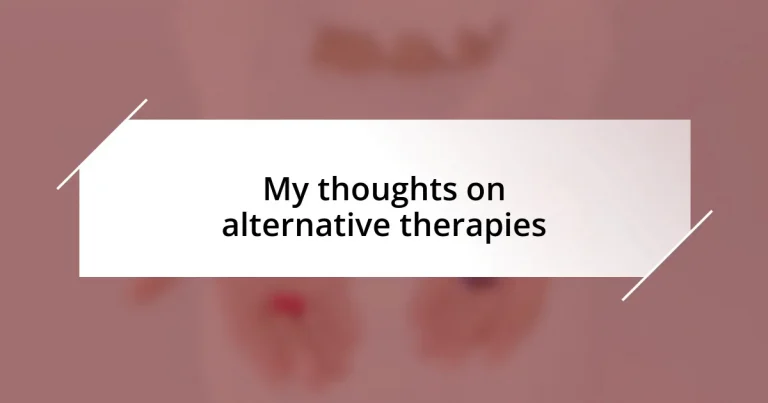Key takeaways:
- Alternative therapies, such as acupuncture, herbal medicine, and yoga, focus on holistic healing and engage the whole person rather than just treating symptoms.
- Personal experiences play a crucial role in evaluating the effectiveness of alternative therapies, emphasizing that what works for one individual may not resonate with another.
- Integrating alternative therapies with conventional medicine can enhance overall well-being, promoting patient autonomy and collaborative care between healthcare providers.
- Safety considerations, including potential interactions and practitioner qualifications, are essential when exploring alternative treatments to ensure a beneficial experience.

Understanding alternative therapies
Alternative therapies encompass a diverse range of practices that often lie outside conventional medicine. I remember my first experience with acupuncture; I was skeptical at first, but the sense of calm that washed over me afterward was undeniable. Have you ever found yourself questioning whether there’s more to healing than just pills and prescriptions?
These therapies can include anything from herbal medicine to mindfulness techniques, and each aims to treat the whole person rather than just the symptoms. I’ve spoken with many people who swear by yoga for stress relief, sharing how it transformed their approach to mental wellness. Doesn’t it make you wonder how a simple shift in perspective could lead to profound changes in one’s health?
What’s fascinating to me is how these practices often tap into the body’s natural healing mechanisms. When I tried aromatherapy for the first time, certain scents not only lifted my spirits but also helped ease my tension. It left me pondering: could our senses truly influence our well-being in such a powerful way? Exploring alternative therapies invites us to connect deeper with our bodies and emotions, offering insights that modern medicine sometimes overlooks.

Benefits of alternative therapies
Alternative therapies offer numerous benefits that extend beyond conventional treatments. For instance, I’ve noticed how practices like meditation have significantly improved my mental clarity and emotional resilience. Have you ever experienced a moment where everything just seemed to fall into place after a few minutes of stillness? That sense of grounding can be a powerful tool for coping with life’s challenges.
One compelling aspect of alternative therapies is their focus on holistic health. Unlike traditional approaches that often prioritize symptoms, these therapies engage the whole person, promoting balance in both mind and body. I remember attending a workshop on herbal medicine, where I learned how plants can balance moods or even improve sleep quality. Seeing that connection made me realize how our natural world provides resources we can utilize for better health.
Additionally, many alternative therapies foster a strong sense of community and support. I once joined a local group for sound healing sessions, where participants shared their experiences and fostered an environment of understanding. This camaraderie can be incredibly healing in itself, reinforcing the idea that we are not alone in our journeys toward wellness.
| Benefit | Description |
|---|---|
| Mental Clarity | Practices like meditation enhance focus and emotional balance. |
| Holistic Approach | Engages the whole person, addressing both physical and emotional needs. |
| Community Support | Emphasizes shared experiences, fostering connection and understanding. |

Common types of alternative therapies
I’ve come across many types of alternative therapies over the years. Each one uniquely contributes to holistic healing. It still amazes me how some modalities resonate deeply with individuals and foster profound changes. Here are a few common types you might encounter:
- Acupuncture: Inserting thin needles at specific points to promote energy flow.
- Herbal Medicine: Utilizing plants and their extracts to support health and wellness.
- Yoga: Combining physical postures, breathing techniques, and meditation for overall balance.
- Chiropractic: Focusing on spinal alignment to enhance physical function.
- Aromatherapy: Using essential oils to improve mood and well-being.
I remember being introduced to Reiki during a community wellness fair. It was fascinating to feel the gentle energy flow without being physically touched. That experience sparked my curiosity about energy healing practices. I realized how these therapies could not only complement traditional medicine but also enhance emotional and spiritual well-being. The diversity of options available truly speaks to the personalized journey of healing.

Evaluating the effectiveness of therapies
When evaluating the effectiveness of alternative therapies, it’s important to consider personal experiences alongside scientific research. I recall attending a workshop on massage therapy where practitioners shared their client success stories. Hearing how individuals found relief from chronic pain inspired me to genuinely reflect on whether these therapies could truly align with medical practices. Are anecdotal outcomes enough to establish credibility in alternative treatments?
Evidence-based studies often point to varying degrees of success with these therapies. I’ve seen some friends achieve remarkable results with acupuncture, particularly in managing stress and anxiety. On the other hand, others have expressed skepticism due to a lack of consistent scientific backing. This disparity raises an essential question: How much weight should personal experiences hold when assessing therapeutic effectiveness?
As I navigated this landscape, I discovered the importance of individual response. For instance, while yoga classes transformed my flexibility and mental outlook, a close friend found them overwhelming and instead thrived in tai chi sessions. This highlights a crucial lesson: what works wonders for one person might not resonate with another. Isn’t it fascinating how personal journeys influence the landscape of healing?

Safety considerations in alternative treatments
When considering alternative therapies, safety should always be at the forefront. I remember my first experience with herbal supplements; I was eager to try a new remedy but didn’t realize that some herbs can interact with medications. This made me wonder: how often do people overlook potential side effects because they’re driven by the promise of natural healing?
Furthermore, the qualifications of practitioners often vary widely across different modalities. I once had a consultation with a massage therapist who was incredibly knowledgeable, but I’ve also encountered those who seemed less experienced. This inconsistency raises a pivotal question: how can we trust the safety of a treatment if the person administering it lacks proper training?
Lastly, individual health conditions can significantly influence reactions to alternative treatments. For example, I’ve read about cases where individuals with allergies had unexpected reactions to essential oils, rendering what should be a soothing experience into a distressing one. Isn’t it crucial to consider our unique health backgrounds and to communicate openly with practitioners? Taking these safety measures seriously can make the difference between a beneficial experience and one that complicates our health journey.

Integrating therapies with conventional medicine
Integrating alternative therapies with conventional medicine can create a holistic approach to health and well-being. I vividly remember a time when my doctor suggested combining acupuncture sessions with my treatment for migraines. At first, it felt a bit unconventional, but the results were truly enlightening. I found that the acupuncture complemented my medication perfectly, improving my overall quality of life. Isn’t it intriguing how melding different approaches can enhance healing?
I often reflect on how collaboration between healthcare providers is essential in this integration process. I attended a seminar where integrative medicine advocates emphasized the importance of communication between conventional doctors and alternative practitioners. Hearing stories from professionals who continued working together to create personalized treatment plans made me realize that openness in discussing therapies is key. How often do we imagine these worlds colliding seamlessly?
The balance between alternative treatments and conventional care also invites discussions about patient autonomy. For instance, I had a friend who felt empowered by choosing to incorporate dietary changes alongside her prescribed medications for diabetes. Her excitement about taking control of her health was infectious; it reminded me that when patients are actively involved, they tend to be more committed to their treatment plans. Isn’t it powerful to think that integration can not only address the medical aspects but also elevate one’s sense of agency in their health journey?

Personal experiences with alternative therapies
I have had several interesting encounters with alternative therapies that shaped my perspective significantly. One time, I decided to try guided meditation to help with anxiety. I remember sitting in a softly lit room, surrounded by calming scents, and feeling an overwhelming sense of peace wash over me. This experience made me wonder: can something as simple as meditation truly shift our emotional state? In my case, it absolutely did, opening my eyes to the potential of mindfulness as a daily practice.
Visiting a Reiki healer was another eye-opening experience for me. I approached it with skepticism, apprehensive about the whole “energy healing” concept, yet I was unexpectedly moved. As she placed her hands just above my body, I could literally feel warmth radiating through my energy field, sparking an unfamiliar sense of relaxation. It left me questioning how much we can genuinely perceive beyond the physical sensations we often prioritize. Was this merely a placebo effect, or was it a deeper connection to my own energy? Regardless, I felt lighter and more centered afterward, prompting me to explore this intriguing realm further.
Another memorable moment came when I attended a sound therapy session. I wasn’t quite sure what to expect but found myself enveloped by harmonious sounds from various instruments. I closed my eyes and allowed the vibrations to resonate within me. Afterward, I felt a significant release of tension in both my body and mind. Reflecting on that experience, I realized how essential it is to seek out what resonates personally, as that genuine connection can lead to profound healing moments. Could it be that sometimes the most unconventional therapies offer the most significant breakthroughs?













